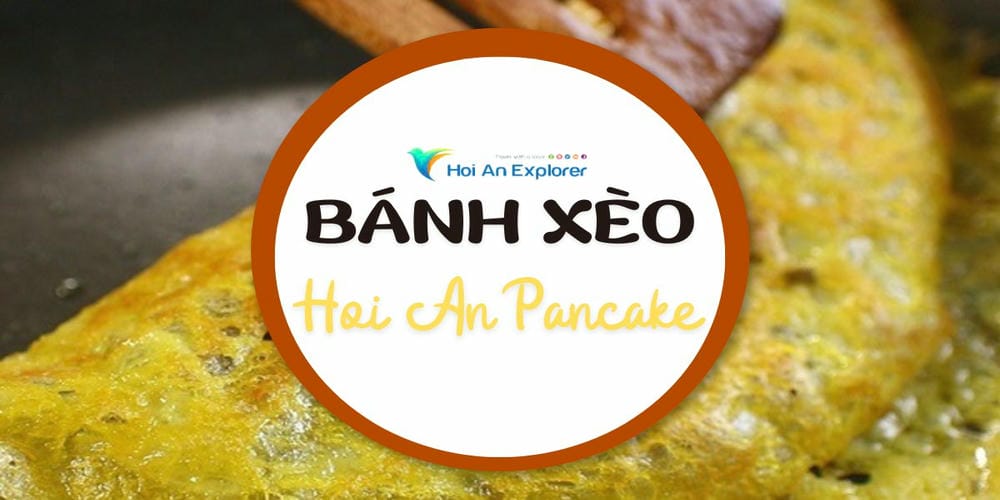My Chaotic but Fun Experience Making Bánh Xèo in Hoi An, Da Nang Viet Nam
Let me tell you about the time I tried making Bánh xèo those crispy, golden Vietnamese pancakes in Hoi An. Heads up: it was a bit of a disaster, but in the best possible way!
It all started when I signed up for a Hoi An cooking class. You know, one of those touristy things you do to feel like you’re truly immersing yourself in the culture. The class was held in a beautiful open-air kitchen, buzzing with travelers from all over the world. Our instructor, a tiny but energetic local woman from Hoi An, handed me a ladle and said, “Now, make Bánh xèo!” Uh… okay, but how? Let’s find out together.

Banh Xeo Hoi An street foods
What’s in Bánh Xèo Name?
The name of Bánh xèo comes from the sizzling sound (“xèo xèo”) the batter makes when it hits the hot pan. That alone tells you this dish has been around for ages, its identity is tied to both sound and taste.
How Old is Bánh Xèo?
No one really knows the exact origin of Bánh xèo, but one thing’s for sure, it’s been a part of Vietnamese cuisine for a long time. It’s a traditional street food, loved across Vietnam, which means generations have perfected it over time.
It’s not just everyday food, it also reflects the delicate art of Hoi An cooking class Vietnamese. Variations of Bánh xèo exist in Cambodia and Thailand, showing how Southeast Asian cuisines influence one another.
So while we can’t pinpoint the exact year bánh xèo was born, it’s safe to say it’s been a beloved dish for centuries.

Banh Xeo Hoi An street foods
Preparing to Make Bánh Xèo
Like any dish, Bánh xèo starts with fresh, quality ingredients. Depending on the region, recipes may vary, but the basics remain the same.
For the Batter
- Rice flour – The key to that crispy texture.
- Turmeric powder – For that signature golden color.
- Coconut milk – Adds a rich, slightly sweet taste.
- Water or beer – Helps create a smooth, thin batter.
- Green onions – Adds a mild, fragrant touch.
- Seasonings – A bit of salt, sugar, and MSG (optional).
For the Filling
- Fresh prawns – Sweet and juicy, perfect for the pancake.
- Pork belly – Adds a delicious, savory fattiness.
- Mung beans (peeled and boiled) – Gives the filling a nutty, creamy balance.
- Bean sprouts – Brings freshness and crunch.
- Onions – Enhances the flavor.
- Fresh herbs & greens – Lettuce, basil, Vietnamese coriander, and perilla leaves.
For the Dipping Sauce
- Fish sauce
- Sugar
- Lime or vinegar
- Garlic
- Chili
- Grated carrot (optional)
- Some people like to switch things up by adding mushrooms, squid, or even beef. Totally up to you!

Banh Xeo Hoi An street foods
What Do You Call Bánh Xèo in English?
There’s no perfect translation, but here are the most common ways people describe Bánh xèo:
- Vietnamese pancake – Because it looks a bit like a French crepe.
- Crispy Vietnamese pancake – Highlights the crunchiness and the fact that it’s pan-fried.
- Simply “Bánh xèo” – Some people just stick with the original name because, well, why not?
Back to my Hoi An cooking class did my Bánh xèo turn out perfect? Nope. But did I have the best time trying? Absolutely. Cooking it was a wild, slightly messy adventure, but eating it? That part was pure joy. If you ever get the chance, try making Bánh xèo yourself. Even if you mess up, trust me, it’ll still taste amazing
The Plan: Recreate That Perfect Crunch
I wanted to get that golden, super crispy, slightly chewy texture that Bánh xèo from Hoi An has. So I did what any amateur home cook does. I found a recipe online, skimmed it (because who actually reads recipes properly?), and went straight to work.
For the Batter
- 1 cup rice flour
- ½ cup cornstarch (apparently, this makes it crispier—who knew?)
- ½ teaspoon turmeric powder (for that classic yellow color)
- ½ teaspoon salt
- 1 ½ cups coconut milk (because Bánh xèo needs that rich, creamy flavor)
- 1 cup water (or beer, because beer supposedly makes it extra crispy—of course, I went with beer)
- 2 tablespoons chopped green onions
For the Filling
- 8 oz shrimp (peeled and deveined, because dealing with shells is a hassle)
- 8 oz pork belly (thinly sliced, because crispy fatty bits = heaven)
- 1 cup cooked mung beans (soft, slightly nutty, and somehow essential)
- 1 cup bean sprouts (for that fresh crunch)
- ½ onion (thinly sliced)
- A whole lot of vegetable oil (because crispy needs oil, no way around it)
For the Dipping Sauce
- 3 tablespoons fish sauce (the real deal, not the watered-down kind)
- 3 tablespoons water
- 2 tablespoons sugar
- 2 tablespoons lime juice (fresh, not the bottled stuff)
- 1 clove garlic, minced
- 1 red chili, minced (because Bánh xèo needs a little heat)
- Optional: shredded carrot (for some extra texture)
For Serving
- Fresh lettuce leaves
- Herbs (mint, basil, cilantro—basically anything green and fragrant)
- Rice paper (optional, but it makes things fun)
The Cooking Process (Chaos in My Kitchen)
Step 1: Making the Batter
I dumped all the batter ingredients into a bowl and mixed. Easy, right? Wrong. It looked too thick, so I added more beer. Then it looked too thin, so I panicked and added more flour. After a few back-and-forths, I decided “Eh, close enough!” and moved on.
Step 2: Prepping the Filling
Fried the pork belly first—because crispy pork is life. Then the shrimp. Easy enough, no disasters yet.
Step 3: Cooking the Pancakes
Now, this is where things got real. I heated up a pan, poured in some oil (okay, a lot of oil), and added a thin layer of batter. It sizzled beautifully, so I threw in some pork, shrimp, onions, and mung beans. Then I made a rookie mistake—I added too many bean sprouts too soon, and they released water, making the pancake less crispy. Oops. Lesson learned.
- The first pancake came out meh—not crispy enough. The second one? Slightly better. By the third one, I was in the zone. The trick? High heat, patience, and not touching it too soon.
How to Eat Bánh Xèo Like a Pro
This is the fun part
- Take a piece of Bánh xèo (try not to break it—it’s fragile).
- Wrap it in a lettuce leaf with some herbs.
- If you want the full Hoi An experience, wrap it in rice paper first, then add the herbs and pancake inside.
- Dip it in nước chấm.
- Take a big, satisfying bite.
That first bite? Pure bliss. Crunchy, flavorful, slightly sweet from the coconut milk, a little smoky from the pork, fresh from the herbs. Exactly how I remembered it from Vietnam.
Final Thoughts: Would I Make It Again?
Absolutely. Was it perfect? Nope. But did I eat every single piece? You bet. If you’re thinking about making
The Plan: Recreate That Perfect Crunch
I wanted to get that golden, super crispy, slightly chewy texture that Bánh xèo from Hoi An has. So I did what any amateur home cook does. I found a recipe online, skimmed it (because who actually reads recipes properly?), and went straight to work.
Here’s What I Used
For the Batter
- 1 cup rice flour
- ½ cup cornstarch (apparently, this makes it crispier—who knew?)
- ½ teaspoon turmeric powder (for that classic yellow color)
- ½ teaspoon salt
- 1 ½ cups coconut milk (because Bánh xèo needs that rich, creamy flavor)
- 1 cup water (or beer, because beer supposedly makes it extra crispy—of course, I went with beer)
- 2 tablespoons chopped green onions
For the Filling
- 8 oz shrimp (peeled and deveined, because dealing with shells is a hassle)
- 8 oz pork belly (thinly sliced, because crispy fatty bits = heaven)
- 1 cup cooked mung beans (soft, slightly nutty, and somehow essential)
- 1 cup bean sprouts (for that fresh crunch)
- ½ onion (thinly sliced)
- A whole lot of vegetable oil (because crispy needs oil, no way around it)
For the Dipping Sauce
- 3 tablespoons fish sauce (the real deal, not the watered-down kind)
- 3 tablespoons water
- 2 tablespoons sugar
- 2 tablespoons lime juice (fresh, not the bottled stuff)
- 1 clove garlic, minced
- 1 red chili, minced (because Bánh xèo needs a little heat)
- Optional: shredded carrot (for some extra texture)
For Serving
- Fresh lettuce leaves
- Herbs (mint, basil, cilantro—basically anything green and fragrant)
- Rice paper (optional, but it makes things fun)
The Cooking Process (a.k.a. Chaos in My Kitchen)
Step 1: Making the Batter
I dumped all the batter ingredients into a bowl and mixed. Easy, right? Wrong. It looked too thick, so I added more beer. Then it looked too thin, so I panicked and added more flour. After a few back-and-forths, I decided “Eh, close enough!” and moved on.
Step 2: Prepping the Filling
Fried the pork belly first—because crispy pork is life. Then the shrimp. Easy enough, no disasters yet.
Step 3: Cooking the Pancakes
Now, this is where things got real. I heated up a pan, poured in some oil (okay, a lot of oil), and added a thin layer of batter. It sizzled beautifully, so I threw in some pork, shrimp, onions, and mung beans. Then I made a rookie mistake—I added too many bean sprouts too soon, and they released water, making the pancake less crispy. Oops. Lesson learned.
The first pancake came out meh—not crispy enough. The second one? Slightly better. By the third one, I was in the zone. The trick? High heat, patience, and not touching it too soon.
How to Eat Bánh Xèo Like a Pro
This is the fun part
- Take a piece of Bánh xèo (try not to break it—it’s fragile).
- Wrap it in a lettuce leaf with some herbs.
- If you want the full Hoi An experience, wrap it in rice paper first, then add the herbs and pancake inside.
- Dip it is Nuoc Cham
- Take a big, satisfying bite.
That first bite? Pure bliss. Crunchy, flavorful, slightly sweet from the coconut milk, a little smoky from the pork, fresh from the herbs. Exactly how I remembered it from Vietnam.
Final Thoughts: Would I Make It Again?
Absolutely. Was it perfect? Nope. But did I eat every single piece? You bet. If you’re thinking about making Bánh xèo, do it! Worst case, your kitchen gets covered in oil splatters. Best case? You end up with one of the best homemade Vietnamese dishes ever.
Either way, it’s a win do it! Worst case, your kitchen gets covered in oil splatters. Best case? You end up with one of the best homemade Vietnamese dishes ever. Either way, it’s a win.




